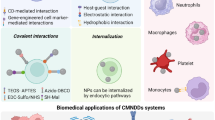Abstract
The previous observation with an electron microscope showed that extremely low frequency (ELF) pulsed magnetic field (PMF) (with the maximum intensity of 0.6–2.0T, gradient of 10–100 T·M−1, pulse width of 20–200 ms and frequency of 0.16–1.34 Hz) inhibited the growth of S-180 sarcoma in mice and enhanced the ability of immune cell’s dissolving sarcoma cells. In this study, the DNA contents of nuclei were assayed by using Faulgen Staining method. With an electron microscope and cell stereoscopy technology it was observed that magnetic field affected the sarcoma cell ’s metabolism, lowered its malignancy, and restrained its rapid and heteromorphic growth. The magnetic field enhanced the cellular immune ability and the reaction of lymphocytes and plasma. Since ELF pulsed magnetic fields can inhibit the growth of sarcomas and enhance the cellular immune ability, it is possible to use it as a new method to treat cancer.
Similar content being viewed by others
References
Li Guodong, Zhou Wansong, Guo Liwenget al.,Biomagnetism-Application, Technology and Principle (in Chinese), Beijing: National Defense Industry Press, 1993, 97–103;89.
Halpern, M. H., Greene, A. E., Effects of magnetic fields on growth of Hela cells in tissure culture,Nature, 1964, 4933: 717.
Mulay, I. L., Mulay, L. N., Effects of a magnetic field on sarcoma 37 ascites tumour cells,Nature, 1961, 4780:1019.
Zhang Xiaoyun, Liu Dong, Zhang Yuhenget al., Effect of magnetic field on cell division and the probe of its mechanism,Science in China (in Chinese), Ser.B, 1989, 19(2): 164.
Chang Hanying, Li Guilan, Pan Yuminget al., Experimental observation on the effect of magnetic field on S-180 sarcomas in mice,Chinese Journal of Physics Medicine (in Chinese), 1985, 7(3): 169.
Chang Hanying, Li Guilan, Wang Guozhuet al., Primary report of 18 cases on magnetic field therapy for malignant tumour, inBiomedical Physics Study (in Chinese), Wuhan: Wuhan University Press, 1990, 74.
Zhou Wansong, Applied advence of magnetic field therapy for tumour,Chinese Biomagnetism (in Chinese), 1994, 8(2):1.
Zhang Husheng, Ye Hui, Zhang Qingchuanet al., SEM and TEM observations on inhibitory effect of ultralow frequency pulse magnetic field on mice’s S-180 Sarcomas,Chinese Science Bulletin (in Chinese), 1994, 39(21):2000.
Zhang Husheng, Jin Xiangrui, Ye Huiet al., Extremely low frequency pulsed magnetic field restrains cancer cells in animal and human, inBiomagnetism Study and Application (in Chinese), Beijing: Atomic Energy Press, 1994, 18.
Sheng Hong, 3D-shape Factor—study on the calculation of spherical degree,Chinese Physimedical Journal (in Chinese), 1992, 14(1):39.
Shimokawara, I., Imamura, M., Yamanaka, N., Identification of lymphyocyte subpopulations in human breast cancer tissue and its significance,Cancer, 1982, 49:1456.
Bennet, S. H., Futrell, J. W., Roth, J. A., Prognostic significance of histologic host response in cancer of the Larynx or HypoLarynx,Cancer, 1971, 28:1255.
Pierce, G. B., Shikes, R., Fink, L. M.,Cancer-A Problem of Developmental Biology, Beijing: Science Press, 1978.
Chen Yansheng, Luo Minyong, Jin Xingmeiet al., Effect of magnetic field on haemorheology, inBiomedical Physics Study, Beijing: Atomic Energy Press, 1992, 25–26.
Author information
Authors and Affiliations
Rights and permissions
About this article
Cite this article
Zhang, H., Ye, H., Zhang, C. et al. Experimental studies on extremely low frequency pulsed magnetic field inhibiting sarcoma and enhancing cellular immune functions. Sci. China Ser. C.-Life Sci. 40, 392–397 (1997). https://doi.org/10.1007/BF02881733
Received:
Issue Date:
DOI: https://doi.org/10.1007/BF02881733




